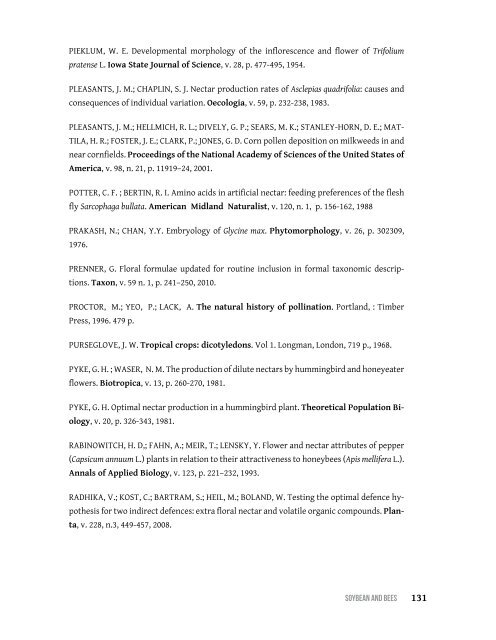Soybean and Bees
You also want an ePaper? Increase the reach of your titles
YUMPU automatically turns print PDFs into web optimized ePapers that Google loves.
PIEKLUM, W. E. Developmental morphology of the inflorescence <strong>and</strong> flower of Trifolium<br />
pratense L. Iowa State Journal of Science, v. 28, p. 477-495, 1954.<br />
PLEASANTS, J. M.; CHAPLIN, S. J. Nectar production rates of Asclepias quadrifolia: causes <strong>and</strong><br />
consequences of individual variation. Oecologia, v. 59, p. 232-238, 1983.<br />
PLEASANTS, J. M.; HELLMICH, R. L.; DIVELY, G. P.; SEARS, M. K.; STANLEY-HORN, D. E.; MAT-<br />
TILA, H. R.; FOSTER, J. E.; CLARK, P.; JONES, G. D. Corn pollen deposition on milkweeds in <strong>and</strong><br />
near cornfields. Proceedings of the National Academy of Sciences of the United States of<br />
America, v. 98, n. 21, p. 11919–24, 2001.<br />
POTTER, C. F. ; BERTIN, R. I. Amino acids in artificial nectar: feeding preferences of the flesh<br />
fly Sarcophaga bullata. American Midl<strong>and</strong> Naturalist, v. 120, n. 1, p. 156-162, 1988<br />
PRAKASH, N.; CHAN, Y.Y. Embryology of Glycine max. Phytomorphology, v. 26, p. 302309,<br />
1976.<br />
PRENNER, G. Floral formulae updated for routine inclusion in formal taxonomic descriptions.<br />
Taxon, v. 59 n. 1, p. 241–250, 2010.<br />
PROCTOR, M.; YEO, P.; LACK, A. The natural history of pollination. Portl<strong>and</strong>, : Timber<br />
Press, 1996. 479 p.<br />
PURSEGLOVE, J. W. Tropical crops: dicotyledons. Vol 1. Longman, London, 719 p., 1968.<br />
PYKE, G. H. ; WASER, N. M. The production of dilute nectars by hummingbird <strong>and</strong> honeyeater<br />
flowers. Biotropica, v. 13, p. 260-270, 1981.<br />
PYKE, G. H. Optimal nectar production in a hummingbird plant. Theoretical Population Biology,<br />
v. 20, p. 326-343, 1981.<br />
RABINOWITCH, H. D,; FAHN, A.; MEIR, T.; LENSKY, Y. Flower <strong>and</strong> nectar attributes of pepper<br />
(Capsicum annuum L.) plants in relation to their attractiveness to honeybees (Apis mellifera L.).<br />
Annals of Applied Biology, v. 123, p. 221–232, 1993.<br />
RADHIKA, V.; KOST, C.; BARTRAM, S.; HEIL, M.; BOLAND, W. Testing the optimal defence hypothesis<br />
for two indirect defences: extra floral nectar <strong>and</strong> volatile organic compounds. Planta,<br />
v. 228, n.3, 449-457, 2008.<br />
SoybeAn <strong>and</strong> bees<br />
131


